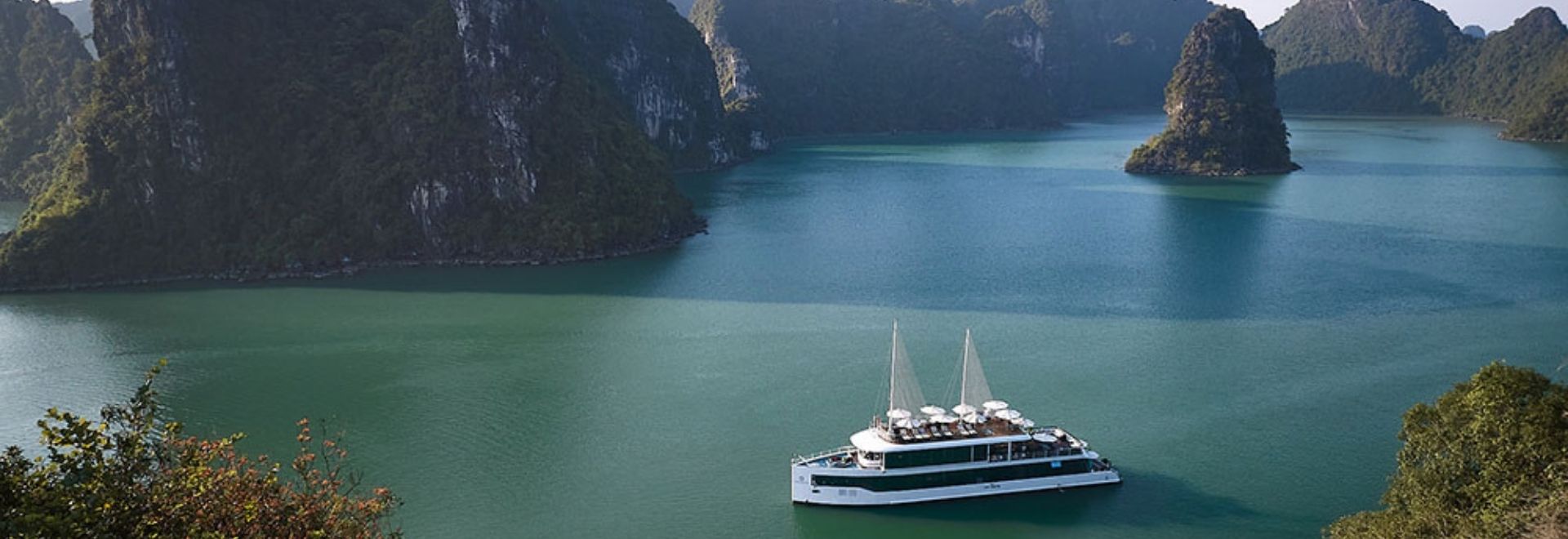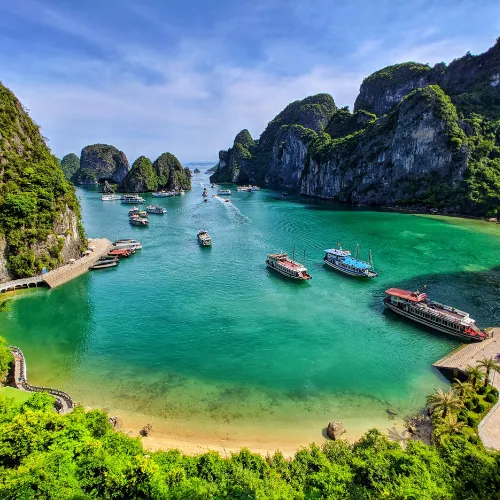Ninh Binh Vietnam
Ninh Binh, about 93 km south of Hanoi, was selected as a primary shooting site for Kong: Skull Island – the famous Hollywood movie. It possesses striking limestone karsts, record-breaking temples and pagodas, amazingly vast rice paddies, making the place exposed to the foreign travel market as well as international travelers.
The province of Ninh Binh also has a rich diversifies tourist potential with a lot of world heritage sites surrounded by stunning landscapes:

Tam Coc – Bich Dong
Tam Coc is considered the most beautiful tourist attraction in Ninh Binh,. Tam Coc (Three Grottoes) includes Hang Ca, Hang Hai and Hang Ba Grottoes. All of 3 caves are formed by Ngo Dong River crashing through mountains…
Bich Dong is a pagoda complex, built in 1428. It is situated on nearby Ngu Nhac Mountain, and consists of three separate pagodas: Hạ, Trung, and Thượng Pagodas, in ascending order. Guided tours generally cover historical points and end with a view from the top. if you dont stay in Ninh Binh, You can take a full day tour to Tam Coc from Hanoi
Cuc Phuong National Park
Cuc Phuong National Park was established in 1962, Cuc Phuong is the oldest national park in Vietnam. It’s only 40 km from Ninh Binh City and nestled between the provinces of Ninh Binh, Hoa Binh and Thanh Hoa, Cuc Phuong boasts an engaging cultural and wildlife heritage and enchanting scenery. Magnificent Limestone Mountains rise up majestically from the green rice-terraces and traditional stilt houses of the Muong hill-tribe. Covered in a dense forest, this landscape forms the habitat for some of Asia’s rarest animal and plant species. It is no wonder that researchers, naturalists, enthusiasts and conservationists alike are drawn to this corner of the world. The ancient forest harbours over 2234 vascular and non-vascular plants, 122 species of reptiles and amphibians, and 135 species mammals, including the Clouded Leopard, Delacour’s Langur, Owston’s Civet and Asian Black Bear. There are also an incredible 336 documented bird species. Visitors in April and May should be blessed with the chance to see literally thousands of vibrant butterflies. Located on 2 limestone mountain ranges, the landscape of Cuc Phuong contains a wonderfully rich ecosystem. The rocky outcrops of Cuc Phuong form the site of valuable pale ontological and anthropological vestiges, including a fossilized sea reptile dated at 200 – 230 million years old, while the remains of prehistoric people who lived in the forest some 7500 years ago are also to be found in the numerous mountain caves. In earlier times, Cuc Phuong was home to the Muong minority people and to this day a few scattered villages around the park’s periphery still house these interesting people and their unique culture. If you visit these communities you can still see their traditional stilt houses, waterwheels, bamboo rafts and brocade looms.
Thung Nham Bird Sanctuary
Thung Nham bird sanctuary is about 12km east of Ninh Binh city, located in the core area of the complex of Trang An landscapes, next to the famous Tam Coc – Bich Dong tourist resort. From Bich Dong Pagoda, about 4km from the road, tourists can come to Thung Nham – the country of birds.
Surrounded by tropical forests on the limestone mountains, many valleys, and caves, blending with grass and flowers, Thung Chim has been given a beautiful natural landscape.
Coming to Thung Nham to explore the wildlife of nearly 40 species of birds with about 50 thousand birds. Especially at sunset, each flock of white storks hovers, shelter in a wetland, then visitors will feel the primitive beauty difficult to find.
Trang An Landscape Complex
Trang An is located 3 km south of Hoa Lu ancient capital, 7 km from Ninh Binh city to the west along Trang An boulevard, 16 km from Tam Diep city in the north through Tam Coc. Trang An – Tam Coc zone has an area of more than 6,172 ha, which is a special protection area of scenic spots. This special protection zone is located within Hoa Lu special-use forest, belonging to Hoa Lu ancient capital preservation plan and also under the planning of Trang An World Heritage site with an area of 12,252 ha. In the Trang An landscape complex, the center of Hoa Lu ancient capital in the north, Tam Coc – Bich Dong tourist area is in the south and Trang An eco-tourism area is in the central position. These three areas are linked together by Hoa Lu special-use forest on limestone mountains and rivers, lakes and swamps
Kenh Ga
Kenh Ga Floating Village is located on the bank of Hoang Long river in Gia Thinh commune, Gia Vien district and it is about 15km far from Ninh Binh city center to the Northwest. The name Kenh Ga actually means Chicken Canal that is derived from a hot spring in which water is used to pluck the chicken’s feather.
In Kenh Ga Floating Village that is surrounded by great limestone formations and massive rocks, the entire community lives on the river for the most of the year. Each year, the village welcomes relatively few visitors, compared to nearby Hoa Lu and other famous attractions of Ninh Binh (Ninh Bình). The main reason is that tourists can reach this village only by boat. But if you have the chance to come here, it will be a unique experience as you cannot find anywhere in Vietnam that combines an authentic floating market village with the stunning limestone landscape. As the most rural area in the Red River Delta,
Kenh Ga is a combination of traditional rural lifestyle, beautiful countryside landscapes, and friendly local folk.
When you want to visit Kenh Ga Floating Village in Ninh Binh, you should hire a motorboat at the pier to take the tour around the village which might take you for an hour. These boat trips are managed through the local government tourism agency and their operation is kept relatively hassle-free and low-key.
Van Long Wetland Nature Reserve
Van Long Wetland Nature Reserve is about 15 kms from Ninh Binh City covers more than 3,000 hectares in Gia Vien district, Ninh Binh Vietnam. This is a beautiful site that holds two national records for having the most Delacour’s langurs and for being the largest unspoiled landscape in Vietnam. Van Long Nature Reserve is a popular eco-tourism destination.
Van Long is a land full of mysteries, is an ideal home for plants and animals. It is home to 457 species of higher plants, including eight species listed in Red Book of Viet Nam. It compote 39 species of animals including 12 species is rare and precious as primates, lorises, chamois, bears, etc., and especially the famous monkey pants leg. A poetic picture unfolds before your eyes: the mountains kiss the clouds, reflecting in the water surface forming a spectacle neither real nor imaginary. The purpose of the mountains Quan, Nghien, Trong interned with green trees whose leaves feed the monkeys in pants leg. Those animals do vibrant in these mountainous areas and in the Cuc Phuong National Park. During the day, we can see down to eat or drink. The boat glides over the carpet of algae preserved. The Marble Mountains with their legends take visitors to a magical world.
Van Long is nicknamed “a bay without waves” because the water is as calm as a giant mirror reflecting mountains and clouds. The reserve has a thousand caves, each with its own legend. Do Thi Theu is a boat rower:“From here, one can clearly see rough lines on the cliff from the top to the foot of the mountain which looks like marks left by the claws of a cat. This cliff is listed in the book of Vietnam Records as “the largest stone mass”.
Dinh & Le Temples In Hoa Lu
Visit Hoa Lu, You should not miss Dinh and Le Temples . Dinh Temple worships King Dinh Tien Hoang and Le Temple worships King Le Dai Hanh. These twon temples were built in 17th century.
Dinh Temple was built in the shape of a Chinese character. Through the first entrance called Ngo Mon, there is a stone royal bed with Nghe (imaginary animals of the old times) standing on both sides. Inside the temple is Khai Thanh in worship of Emperor Dinh’s parents.The temple consists of three parts: Bai Duong for the community, Thien Huong in honour of mandarins, and Chinh Cung where Dinh Tien Hoang’s statue is located. On his left is the statue of his eldest son Dinh Lien, and on his right are those of Dinh Hang Lang and Dinh Toan. On each side of the altar, there is one stone dragon similar to the ones placed near the royal bed.
Le Temple is almost the same as Dinh Temple in term of architectural design, except for some details. Le Temple also consists of three parts: Bai Duong used for the community, Thien Huong, in memory of the royal mandarins of King Le, and finally, the altar in memory of the King. The Le Hoan Statue is at the centre, on the left is the statue of Queen Duong Van Nga and on his right is that of Le Ngoa Trieu, his fifth son and the third King of the Pre Le Dynasty.
Bai Dinh Pagoda
The First Bai Dinh Pagoda is a complex of Buddhist temples on Bai Dinh Mountain in Gia Vien District, Ninh Binh Province, Vietnam. The compound consists of the original old temple and a newly created larger Pagoda. It is considered the largest complex of Buddhist temples in Vietnam and has become a popular site for Buddhist pilgrimages from across Vietnam.
The New Bai Dinh Pagoda encompasses an area of 700 hectares, located on Ba Rau hills, near the Hoang Long River. This is a large complex which includes many structures built over several phases starting in 2003 and finally completed in 2010. The Pagoda’s architecture follows traditional lines, consisting of large halls, courtyards and enclosures. The huge scale of Bai Dinh makes it strikingly different from previously built Vietnamese Buddhist pagodas, however. The largest structure, the Tam The Hall, rises to 34 m at its roof ridge and measures over 59 m in length. The construction materials include locally quarried stone and timber from Ninh Bình and tiles from Bát Tràng (reinforced concrete was also employed owing to the scale of construction). The temple adheres to traditional Vietnamese design aesthetics with its curve finials and corner eaves soaring outward and upward, resembling a phoenix’s tail. Artisanal works from local handicraft villages were selected for the interior.




